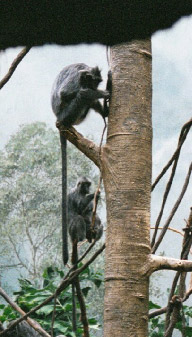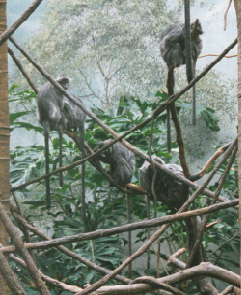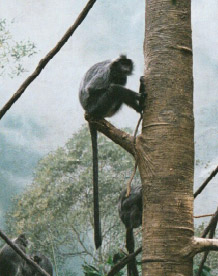The body mass of a male silvered leaf-monkey averages 6.6 kilograms and adult female averages 5.7 kilograms (Fleagle, 1999). Subadult males are about the size of adult females but smaller than fully grown adult males (Bernstein, 1968). The pelage color is a dark gray with the tips of the hairs being paler in color giving it a silvered effect. The groin and the ventral side of the tail are yellowish in coloration (Rowe, 1996). The face is black in coloration and the hair on the head is pointed (Furuya, 1961-2). Adult females have irregular patches of white on the inner portion of the upper thighs (Bernstein, 1968; Furuya, 1961-2). The newborn’s pelage color is orange, with the face, hands, and feet being white (Bernstein, 1968). Infants will darken and the darkening process takes 3-5 months to change to the adult pelage coloration (Bernstein, 1968; Medway, 1970). First the head starts to fade to a yellow orange, then the head, face, hands, feet, and ears turn dark gray and then black (Bernstein, 1968). This species has a sacculated stomach to assist in the breakdown of cellulose. The silvered leaf-monkey has enlarged salivary glands to assist it in breaking down food. The dental formula of this species is 2:1:2:3 on both the upper and lower jaws (Ankel-Simons, 2000).


